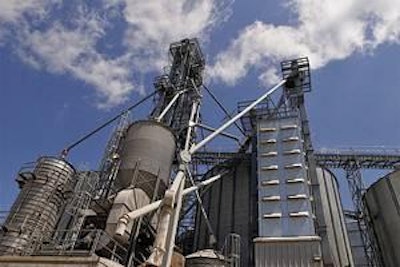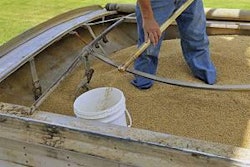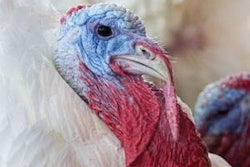
Finding a shared meaning of what sustainability means for the feed industry and animal agriculture is a big, if not impossible, task. As Thad Simons, CEO of Novus International, said at a press conference at the recent World Agricultural Forum in St. Louis: “Sustainability has many meanings, probably “more definitions than the people in this room.”
Three key components
Sustainability must have three components, according to Simons. It has to have an economic foundation, because without profits neither an organization nor a farmer can continue to operate; second, it must benefit the environment; and third, it must have a social aspect.
In addition, sustainability must include food safety—including safe sourcing of ingredients--and animal well being, all of which are part of Novus’s mission. Sustainability has been a key part of Novus’s mission since its inception in 1991. Companies such as Novus have embraced sustainability not only because it’s the right thing to do philosophically in 2009: the only way to feed the world that is going to going to grow by 50% between now and 2050 is through increasingly sustainable agricultural practices.
Feeding a growing population
The need for the safe production of food is going to skyrocket in the years ahead. Alex Avery, director of research for the Hudson Institute, predicts that the demand for food will double between now and 2050, as rising incomes globally increase demand for meat, milk, and eggs.
In Avery’s view, agriculture is far more sustainable today than in past decades. “We didn’t have the tools we have today,” he says.
On the cropping side, the option of using no-till along with fertilizers and herbicides has dramatically reduced soil erosion which was a serious problem in the past.
On the animal agriculture side, serious progress has been made with a model that places a high value on animal waste as a fertilizer that can be integrated into the cropping system. For example, he notes that poultry waste in the Shenandoah Valley has become a highly valued fertilizer resource.
Avery has no doubt that agriculture can rise to meet the challenge of a growing world population in a sustainable way. On the animal agriculture side, this will be accomplished through improved genetics and feed additives that improve feed efficiencies.
More with fewer resources
Jed Harms, president of Kemin Agrifoods North America, says that sustainability means accomplishing more with fewer resources, which agriculture “has been doing an excellent job of,” both on the plant and animal side.
On the crop side, farmers have become more sustainable through practices that require less tillage and using riparian strips. On the animal side, producers have become more sustainable in several ways.
According to Harms, producers are using products to preserve feed quality. In addition, enzymes, biosurfactants, organic trace minerals and other products that Kemin and other companies produce allow animal nutritionists to formulate diets that will utilize nutrients more effectively.
Asked how producers and feed companies can become more sustainable, he comments, “By utilizing emerging technologies, modern animal production is becoming more sustainable.”
Three-pronged approach
To Dr. Aaron Gaines, the Vice President of Production, Resources and Operations for The Maschhoffs, a 130,000-sow operation headquartered in Carlyle, Ill., sustainability must have a three-pronged approach.
“Sustainability must include risk management given the type of (negative) economic environment we’re in, says Gaines. For example, the use of risk pricing tools available to producers.
The second element: environmental compliance, being a responsible citizen. The third prong, he says, and one that’s increasing in importance for his operation and others is animal welfare.
For The Manschhoffs, animal welfare has been important for some time, but additional policies have been implemented within the past couple of years, Gaines says. “We have a zero tolerance policy” for animal abuse.
Any documented cases of animal abuse result in immediate termination of the employee. The entire industry is taking animal welfare more seriously, he says, since an incident in Iowa in October 2008 in which People for the Ethical Treatment of Animals obtained a video showing animals being treated in an inappropriate manner.
The incident was a wake-up call to the industry that unless additional measures were taken pork consumption could be hurt, Gaines says. “We buckled down” and took additional measures.
Manufacturing technology, feed additives
On the feed side, he says that The Manschhoffs’ operation is constantly improving efficiency through both manufacturing technology, such as pelleting and extrusion, and through feed additives, such as enzymes and other products. Especially important, he says, are new additives under development that will allow the use of feeds with more carbohydrates as the industry no longer has the luxury of using a corn/soybean diet.
There is not yet a silver bullet on improving the digestibility of distillers dried grains with soluble (DDGS), “but I’m sure someone will come up” with an enzyme that allows greater use of DDGS for pigs. “Given current biofuels policies, we will have to use alternative ingredients and biofuel coproducts. We were feeding a higher energy diets, but now feed a high-fiber, lower energy diet—a complete switch. The days of corn and soybean diets seem to be over. As things change, you have to change with them. To not change makes you less sustainable. The fact is, we have become more like Europe with our diets,” says Gaines.
One area of sustainability that will receive increasing focus, Gaines says, is “food safety and process verification, the ability to trace feed from the feed mill to the farm site. We want to know what’s in that feed (fed to hogs in each barn). We haven’t fully completed that loop, but we’re working on verification to the site.”
Part of The Manschhoffs dedication to sustainability on food safety is the certification it’s going through to certify its feed mills through the American Feed Industry Association’s Safe Feed/Safe Food program.
“It’s a big initiative you’ll see a lot more of,” Gaines says. The result will be “a higher standard within feed production facilities to guarantee the safety of food for our customers.”
Many questions
Many efforts to improve agricultural sustainability are in the works, and at this stage there are more questions than answers.
“We don’t know if what we are doing today is sustainable in the future,” says Amanda Raster, sustainable standards development coordinator for the Leonardo Academy Inc., in Madison, Wis.
Raster is coordinating an effort to create national goals for farmers to obtain. She says that while goals are important, it’s equally important that the ways to reach them are flexible, because the solutions to become more sustainable are site and size specific.
According to Raster, small and large operations can be sustainable. And while some believe that large operations are less sustainable, a well managed large dairy operation could use fewer resources than an equal number of smaller operations.
That is not to suggest that smaller operations are less sustainable, she comments, just that the answers to sustainability questions are not as simple as they sometimes appear. In addition, she adds that regardless of what people may think about larger operations, “I don’t know if you can change it at this point.”
Raster continues that discussions of sustainability must involve all segments of the supply chain from the grain to livestock producer, all the way to consumer.
The problem with maize
What is not sustainable for animal agriculture is the continued use of maize in feed, according to Dr. Pierce Lyons, founder and president of Alltech. “End stocks of maize is on the decrease,” a trend he expects to continue.
What is sustainable and what will become more of the feeds of the future, Lyons comments, will be fiber feeds, those containing a higher level of cellulose.
He predicts that five to 10 years from now very little maize will be used in animal production. That means it will be increasingly important that products be developed that make the nutrients in fiber and cellulose more available to animals, Lyons comments, adding that his company is involved in such efforts. “We’re going to have to redefine animal nutrition,” he says.
Speaking of sustainability from farm to fork, “the day of reckoning is coming,” says Lyons. “You can’t be just a least cost producer. Sustainability has to begin with economic viability, and that means investing in people and research.


















